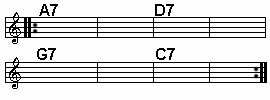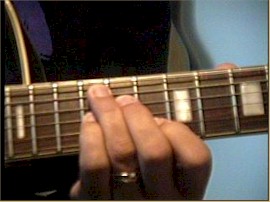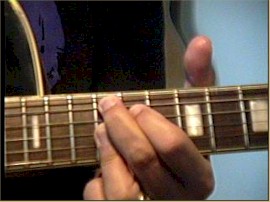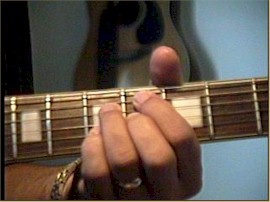Scroll through the lesson and click on notation/video/audio links to load the interactive players.
Please subscribe to get full access to all lessons for only $7.95/month PLUS 1 week free trial.

Riff Interactive lessons are
LESS expensive and
MORE interactive than alternatives!
More Info
|
|

Jazz Guitar For
Beginners
Lesson 3
Lyle:
This lesson will teach you many ways to play chords for a simple 4 chord
progression built all on the dominant 7 chords. You'll also learn and practice
different rhythms.
Lyle: Here's the basic chord
progression:
chord
chart

Lyle: Here's two different jam tracks for you to
choose from. You'll use these to play the exercises with:
Lyle: As
you can see in the chord chart, these are all dominant 7
chords.
Lyle: You can learn many ways to play these. I'd
like to show you a few common ways. Try this next shape of the dominant
chord:
A7

Lyle: This shape is moveable up and down the
neck. The root note is on your 5th
string.
thomas:
I think the jam track tempo has picked up since last
lesson!
Lyle:
yes!
Lyle: Now try playing the progression using these
dominant chord shapes. I want you to strum the chord on beat 1 of each
measure:
Strum on
beat 1

Lyle:
Use the jam track with the counting if that helps.
ZZ:
What
makes these dominants?
Lyle: Try playing along to either of the jam
tracks. Listen to the TAB playback to hear what it should sound like or watch
the video.
Lyle: Dominant chords are major triads with a
flatted 7th.
Lyle: Here's another way to play dom7
chords:
A7 - example
2

Lyle: This time your root note is on the 6th
string. Again, these are all moveable.
Lyle: Mute the 5th and 1st strings with your
fretting hand.
radica: Much
easier to play.
Lyle: Now try playing this shape of the dom7
chords along to the jam tracks, but this time strum on beat 2 of each
measure:
Strum on
beat 2

Lyle: In most cases in Jazz, when you see a chord
chart like the one you are working with here that has plain dominant 7 chords,
you don't have to play just a dominant 7 chord. You can play other dominant chords for
extra color.
ZZ:
Any dominant?
Lyle:
Pretty much any dominant.
Lyle: The plain dom7 chord such as A7 is built on
root, 3, 5, b7. The next dominant chord is the dom9 such as A9. This is built on
root, 3, 5, b7, 9.
A9

Lyle: These dom9 chord shapes sound real cool,
but can be hard to play if they are new to you.
Lyle: Now replace the dom7 chords with these dom9
chords to play against the same jam track. Also, try strumming on beat 3 of each
measure! This will have you
counting.....
Strum
on beat 3

Lyle:
Notice these 9 chords are more colorful than the 7
chords. And the root is on the 5th
string.
radica:
They have a real chime to the sound.
Sweet!
Lyle: Here's another way to play dom9 chords, but
this time you don't have a root note fingered.
A9 - example
2

Lyle: Now try playing these on beat 4 of each
measure like this:
Strum on beat 4

Lyle:
Another popular dominant chord to use is the dom13 chord. This shape is pretty
easy to play and the root note is found on the 1st
string:
A13

Lyle: Now you can substitute the dom7s with these
13 chords.
Lyle: Here's a way I played the rhythm for the 13
chords. I strummed on beat 1 for the first measure of the chord, then I
arpeggiated the chord for the 2nd
measure:
Strum on
beat 1 and arpeggio

radica: It
sounds cool alternating the 7ths with the 13ths as well!
Lyle: Yes, you'll want to learn to mix it all up
in any way you like. Many different combinations are available to you now. Now you have learn 5 different ways to play
that basic chord progression, and 5 different rhythm
ideas!
radica:
Lot's of info here to digest!
Lyle: Next lesson I try to show you a couple ways
to play melodies and improvise over this progression.
|
<< load notation from left
|
|
<< load audio from left
|
<< load audio from left
|